Quantifying the Impact of Cascade Reservoirs on Streamflow, Drought, and Flood in the Jinsha River Basin
Abstract
:1. Introduction
2. Materials and Methods
2.1. Study Area
2.2. Acquisition and Processing of Data
2.3. Assessment Framework and Scenario Setting
2.4. Hydrological Model of the JRB Based on LSTM
2.4.1. LSTM Model
2.4.2. Model Evaluation Indicators
- (1)
- R2:
- (2)
- NSE:
- (3)
- RSR:
- (4)
- PBIAS:
2.5. Flood Characteristics Index
2.6. Drought Characteristics Index
3. Results
3.1. Results of Calibration and Validation
3.2. Quantitative Influence of Reservoirs on Runoff in the JRB
3.3. Changes in Flood Situation
3.4. Changes in Drought Situation
4. Discussion
5. Conclusions
- (1)
- The construction of cascade reservoirs on the JRB reduced the average daily streamflow by 5.69% from 4937.97 m3/s to 4657.10 m3/s. During the rainy and dry seasons, the average daily streamflow decreased by 10.93% and 10.95%, respectively. The cumulative storage capacity and quantity of the reservoirs affect the change degree of the runoff. On the whole, with the increase of the cumulative storage capacity, the effect of the reservoirs on runoff increases, with a non-linear relationship.
- (2)
- The cascade reservoirs on the JRB reduced the flood POT from an average of 2.6 to 2.4 per year, reducing the frequency of floods along the Jinsha River by 7.69%. In terms of the flood magnitude, the construction of reservoirs reduced the average annual runoff exceeding the threshold from 5.25 × 105 m3 to 3.26 × 105 m3, reduced by 37.86%. In other words, cascade reservoirs in the JRB reduce the frequency and magnitude of flood events.
- (3)
- The effect of reservoir construction on drought duration is mainly reflected in the decreasing effect on the duration of extreme drought and the increasing effect on the duration of moderate and severe drought on all timescales. The effect of reservoirs on drought severity is mainly reflected in the mitigation of the severity of extreme drought and the aggravation of the severity of moderate and severe drought. The reservoirs have a mitigating effect on the severity of mild drought on the SRI-1 and SRI-6 timescales and an intensifying effect on the SRI-3 and SRI-6 timescales.
- (4)
- It is suggested that, in the JRB, when the Central Yunnan Water Diversion Project and the South-to-North Water Transfer West Line Project are completed, the water transfer volume and time should be fully considered to co-ordinate with the storage and operation of the cascade reservoirs.
Author Contributions
Funding
Institutional Review Board Statement
Informed Consent Statement
Data Availability Statement
Acknowledgments
Conflicts of Interest
References
- Kuriqi, A.; Pinheiro, A.N.; Sordo-Ward, A.; Garrote, L. Water-energy-ecosystem nexus: Balancing competing interests at a run-of-river hydropower plant coupling a hydrologic-ecohydraulic approach. Energy Convers. Manag. 2020, 223, 113267. [Google Scholar] [CrossRef]
- Talukdar, S.; Pal, S. Effects of damming on the hydrological regime of Punarbhaba river basin wetlands. Ecol. Eng. 2019, 135, 61–74. [Google Scholar] [CrossRef]
- Kelsie, T.; David, K. The changing hydrology of a dammed Amazon. Sci. Adv. 2017, 3, e1700611. [Google Scholar] [CrossRef] [Green Version]
- Yuan, X.; Wang, J.; He, D.; Lu, Y.; Sun, J.; Li, Y.; Li, F. Influence of cascade reservoir operation in the Upper Mekong River on the general hydrological regime: A combined data-driven modeling approach. J. Environ. Manag. 2022, 324, 116339. [Google Scholar] [CrossRef]
- Hu, Y.; Cheng, H. The urgency of assessing the greenhouse gas budgets of hydroelectric reservoirs in China. Nat. Clim. Chang. 2013, 3, 708–712. [Google Scholar] [CrossRef]
- Feng, Y.; Zhou, J.; Mo, L.; Yuan, Z.; Zhang, P.; Wu, J.; Wang, Y. Long-term hydropower generation of cascade reservoirs under future climate changes in Jinsha River in Southwest China. Water 2018, 10, 235. [Google Scholar] [CrossRef] [Green Version]
- Tayyab, M.; Zhou, J.; Zeng, X.; Adnan, R. Discharge forecasting by applying artificial neural networks at the Jinsha River Basin, China. Eur. Sci. J. 2016, 12, 108–127. [Google Scholar] [CrossRef] [Green Version]
- Huang, X.R.; Zhao, J.W.; Yang, P.P. Wet-dry runoff correlation in Western Route of South-to-North Water Diversion Project, China. J. Mt. Sci. 2015, 12, 592–603. [Google Scholar] [CrossRef]
- Lu, X.X.; Ashmore, P.; Wang, J.F. Seasonal water discharge and sediment load changes in the Upper Yangtze, China. Mt. Res. Dev. 2003, 23, 56–64. [Google Scholar] [CrossRef] [Green Version]
- Yu, M.; Li, Q.; Lu, G.; Cai, T.; Xie, W.; Bai, X. Investigation into the Impacts of the Gezhouba and the Three Gorges Reservoirs on the Flow Regime of the Yangtze River. J. Hydrol. Eng. 2013, 18, 1098–1106. [Google Scholar] [CrossRef]
- Long, S.; Gao, J.; Shao, H.; Kang, Y.; Gao, Z.; Guo, Z.; Wang, L. Evaluation of the impact of the Gully Land Consolidation Project on runoff under extreme rainfall. Land Degrad. Dev. 2022, 33, 2663–2676. [Google Scholar] [CrossRef]
- Yuan, X.; Lu, Y.; Jiang, L.; Liang, S.; Jiang, Y.; Xiao, F. Runoff responses to climate change in China’s Buyuan River Basin. River Res. Appl. 2021, 37, 1134–1144. [Google Scholar] [CrossRef]
- Chai, Y.; Li, Y.; Yang, Y.; Zhu, B.; Li, S.; Xu, C.; Liu, C. Influence of climate variability and reservoir operation on streamflow in the Yangtze River. Sci. Rep. 2019, 9, 5060. [Google Scholar] [CrossRef] [PubMed] [Green Version]
- Wang, Y.; Lei, X.; Wen, X.; Fang, G.; Tan, Q.; Tian, Y.; Wang, H. Effects of damming and climatic change on the eco-hydrological system: A case study in the Yalong River, southwest China. Ecol. Indic. 2019, 105, 663–674. [Google Scholar] [CrossRef]
- Bao, A.M.; Liu, H.L.; Chen, X.; Pan, X.L. The effect of estimating areal rainfall using self-similarity topography method on the simulation accuracy of runoff prediction. Hydrol. Process. 2011, 25, 3506–3512. [Google Scholar] [CrossRef]
- McMillan, H.; Freer, J.; Pappenberger, F.; Krueger, T.; Clark, M. Impacts of uncertain river flow data on rainfall-runoff model calibration and discharge predictions. Hydrol. Process. Int. J. 2010, 24, 1270–1284. [Google Scholar] [CrossRef]
- Zhai, M.Y.; Lin, Q.G.; Huang, G.H.; Zhu, L.; An, K.; Li, G.C.; Huang, Y.F. Adaptation of cascade hydropower station scheduling on a headwater stream of the Yangtze River under changing climate conditions. Water 2017, 9, 293. [Google Scholar] [CrossRef] [Green Version]
- Ayzel, G.; Kurochkina, L.; Abramov, D.; Zhuravlev, S. Development of a regional gridded runoff dataset using long short-term memory (LSTM) networks. Hydrology 2021, 8, 6. [Google Scholar] [CrossRef]
- Li, D.; Lu, X.; Yang, X.; Chen, L.; Lin, L. Sediment load responses to climate variation and cascade reservoirs in the Yangtze River: A case study of the Jinsha River. Geomorphology 2018, 322, 41–52. [Google Scholar] [CrossRef]
- Wu, Y.; Fang, H.; Huang, L.; Ouyang, W. Changing runoff due to temperature and precipitation variations in the dammed Jinsha River. J. Hydrol. 2020, 582, 124500. [Google Scholar] [CrossRef]
- Li, W.; Kiaghadi, A.; Dawson, C. High temporal resolution rainfall–runoff modeling using long-short-term-memory (LSTM) networks. Neural Comput. Appl. 2021, 33, 1261–1278. [Google Scholar] [CrossRef]
- Liu, Q.; Zhang, R.; Wang, Y.; Yan, H.; Hong, M. Daily prediction of the arctic sea ice concentration using reanalysis data based on a convolutional lstm network. J. Mar. Sci. Eng. 2021, 9, 330. [Google Scholar] [CrossRef]
- Werbos, P.J. Backpropagation through time: What it does and how to do it. Proc. IEEE 1990, 78, 1550–1560. [Google Scholar] [CrossRef] [Green Version]
- Kratzert, F.; Klotz, D.; Brenner, C.; Schulz, K.; Herrnegger, M. Rainfall–runof modelling using Long Short-Term Memory (LSTM) networks. Hydrol. Earth Syst. Sci. 2018, 22, 6005–6022. [Google Scholar] [CrossRef] [Green Version]
- Krause, P.; Boyle, D.P.; Bäse, F. Comparison of different efficiency criteria for hydrological model assessment. Adv. Geosci. 2005, 5, 89–97. [Google Scholar] [CrossRef] [Green Version]
- Chadalawada, J.; Babovic, V. Review and comparison of performance indices for automatic model induction. J. Hydroinform. 2019, 21, 13–31. [Google Scholar] [CrossRef] [Green Version]
- Moriasi, D.N.; Arnold, J.G.; Van Liew, M.W.; Bingner, R.L.; Harmel, R.D.; Veith, T.L. Model evaluation guidelines for systematic quantification of accuracy in watershed simulations. Trans. ASABE 2007, 50, 885–900. [Google Scholar] [CrossRef]
- Durocher, M.; Mostofi Zadeh, S.; Burn, D.H.; Ashkar, F. Comparison of automatic procedures for selecting flood peaks over threshold based on goodness-of-fit tests. Hydrol. Process. 2018, 32, 2874–2887. [Google Scholar] [CrossRef]
- Hirsch, R.M.; Archfield, S.A. Flood trends: Not higher but more often. Nat. Clim. Chang. 2015, 5, 198–199. [Google Scholar] [CrossRef]
- Yun, X.; Tang, Q.; Wang, J.; Liu, X.; Zhang, Y.; Lu, H.; Chen, D. Impacts of climate change and reservoir operation on streamflow and flood characteristics in the Lancang-Mekong River Basin. J. Hydrol. 2020, 590, 125472. [Google Scholar] [CrossRef]
- McKee, T.B.; Doesken, N.J.; Kleist, J. The relationship of drought frequency and duration to time scales. In Proceedings of the 8th Conference on Applied Climatology, Anaheim, CA, USA, 17–22 January 1993; Volume 17, pp. 179–183. [Google Scholar]
- Sun, Z.; Zhu, X.; Pan, Y.; Zhang, J.; Liu, X. Drought evaluation using the GRACE terrestrial water storage deficit over the Yangtze River Basin, China. Sci. Total Environ. 2018, 634, 727–738. [Google Scholar] [CrossRef] [PubMed]
- Yu, M.; Liu, X.; Li, Q. Impacts of the Three Gorges Reservoir on its immediate downstream hydrological drought regime during 1950–2016. Nat. Hazards 2019, 96, 413–430. [Google Scholar] [CrossRef]
- Wu, J.; Liu, Z.; Yao, H.; Chen, X.; Chen, X.; Zheng, Y.; He, Y. Impacts of reservoir operations on multi-scale correlations between hydrological drought and meteorological drought. J. Hydrol. 2018, 563, 726–736. [Google Scholar] [CrossRef]
- Tu, X.; Du, Y.; Singh, V.P.; Chen, X.; Zhao, Y.; Ma, M.; Wu, H. Bivariate design of hydrological droughts and their alterations under a changing environment. J. Hydrol. Eng. 2019, 24, 4019015. [Google Scholar] [CrossRef]
- Yevjevich, V.M. Objective Approach to Definitions and Investigations of Continental Hydrologic Droughts. Ph.D. Thesis, Colorado State University, Libraries, CO, USA, 1967. [Google Scholar]
- Aredo, M.R.; Hatiye, S.D.; Pingale, S.M. Modeling the rainfall-runoff using MIKE 11 NAM model in Shaya catchment, Ethiopia. Model. Earth Syst. Environ. 2021, 7, 2545–2551. [Google Scholar] [CrossRef]
- Chen, Q.; Chen, H.; Zhang, J.; Hou, Y.; Shen, M.; Chen, J.; Xu, C. Impacts of climate change and LULC change on runoff in the Jinsha River Basin. J. Geogr. Sci. 2020, 30, 85–102. [Google Scholar] [CrossRef] [Green Version]
- Maza, M.; Srivastava, A.; Bisht, D.S.; Raghuwanshi, N.S.; Bandyopadhyay, A.; Chatterjee, C.; Bhadra, A. Simulating hydrological response of a monsoon dominated reservoir catchment and command with heterogeneous cropping pattern using VIC model. J. Earth Syst. Sci. 2020, 129, 200. [Google Scholar] [CrossRef]
- Chen, Y.C.; Gao, J.J.; Bin, Z.H.; Qian, J.Z.; Pei, R.L.; Zhu, H. Application study of IFAS and LSTM models on runoff simulation and flood prediction in the Tokachi River basin. J. Hydroinform. 2021, 23, 1098–1111. [Google Scholar] [CrossRef]
- El Hassan, A.A.; Sharif, H.O.; Jackson, T.; Chintalapudi, S. Performance of a conceptual and physically based model in simulating the response of a semi-urbanized watershed in San Antonio, Texas. Hydrol. Process. 2013, 27, 3394–3408. [Google Scholar] [CrossRef]
- Cho, K.; Kim, Y. Improving streamflow prediction in the WRF-Hydro model with LSTM networks. J. Hydrol. 2022, 605, 127297. [Google Scholar] [CrossRef]
- Zhou, J.; Wang, X.; Yang, C.; Xiong, W. A novel soft sensor modeling approach based on difference-LSTM for complex industrial process. IEEE Trans. Ind. Inform. 2021, 18, 2955–2964. [Google Scholar] [CrossRef]
- Sitterson, J.; Knightes, C.; Parmar, R.; Wolfe, K.; Avant, B.; Muche, M. An Overview of Rainfall-Runoff Model Types; Environmental Protection Agency: Washington, DC, USA, 2018.
- Tian, S.; Xu, M.; Jiang, E.; Wang, G.; Hu, H.; Liu, X. Temporal variations of runoff and sediment load in the upper Yellow River, China. J. Hydrol. 2019, 568, 46–56. [Google Scholar] [CrossRef]
- Lu, Y.; He, D.M.; He, K.W.; Yuan, X. Analysis and calculation of water consumption of hydropower plants in Lancang-Mekong River basin. Adv. Water Sci. 2018, 29, 415–423. [Google Scholar] [CrossRef]
- Guo, C.; Chen, Y.; Xia, W.; Qu, X.; Yuan, H.; Xie, S.; Lin, L.S. Eutrophication and heavy metal pollution patterns in the water suppling lakes of China’s south-to-north water diversion project. Sci. Total Environ. 2020, 711, 134543. [Google Scholar] [CrossRef] [PubMed]
- Xiang, C.; Huang, W.; Zhou, H.; Xue, L.; Wang, Z.; Ma, W. Flow reduction effect on fish habitat below water diversion—A case study of the Central Yunnan Water Diversion Project. Ecol. Eng. 2022, 175, 106499. [Google Scholar] [CrossRef]

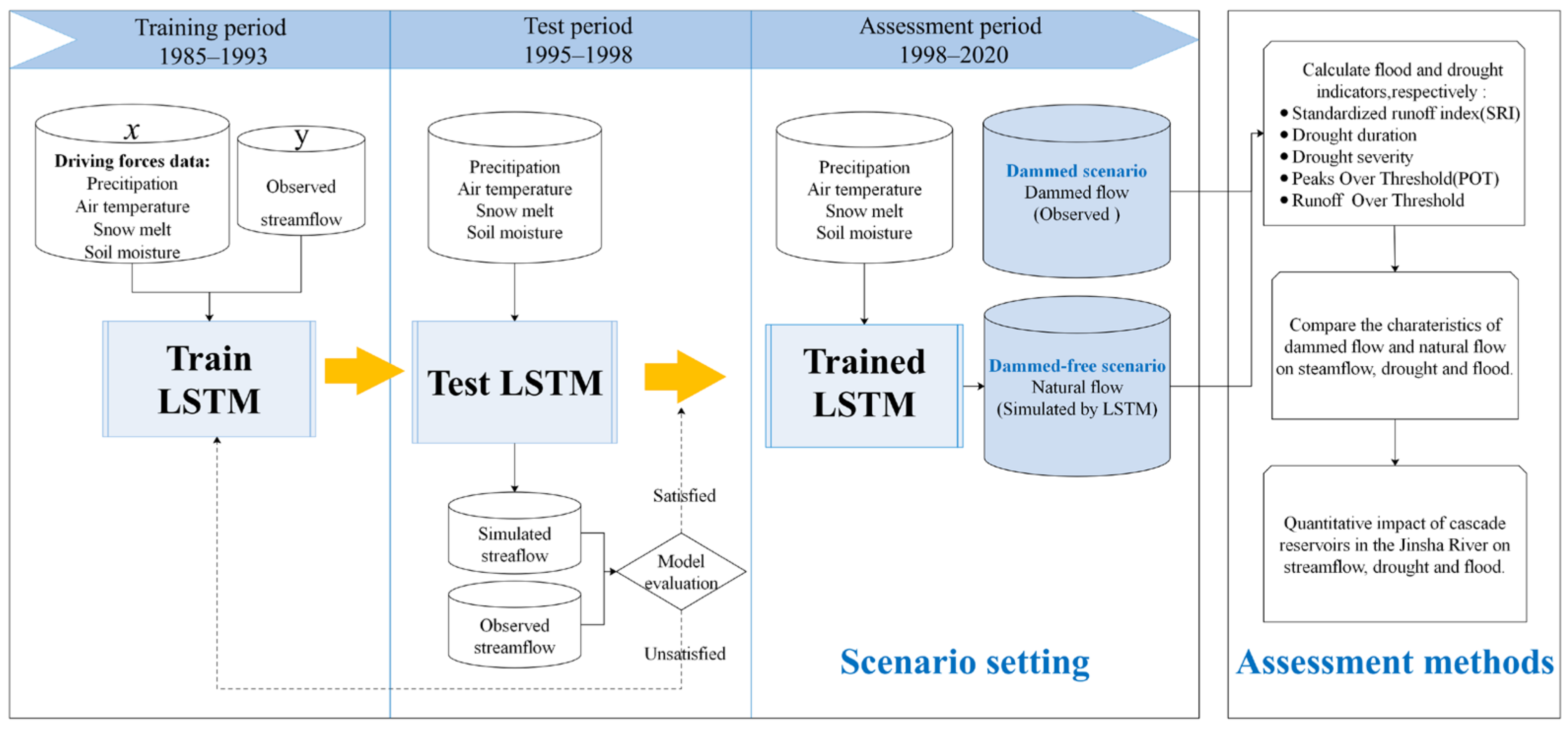


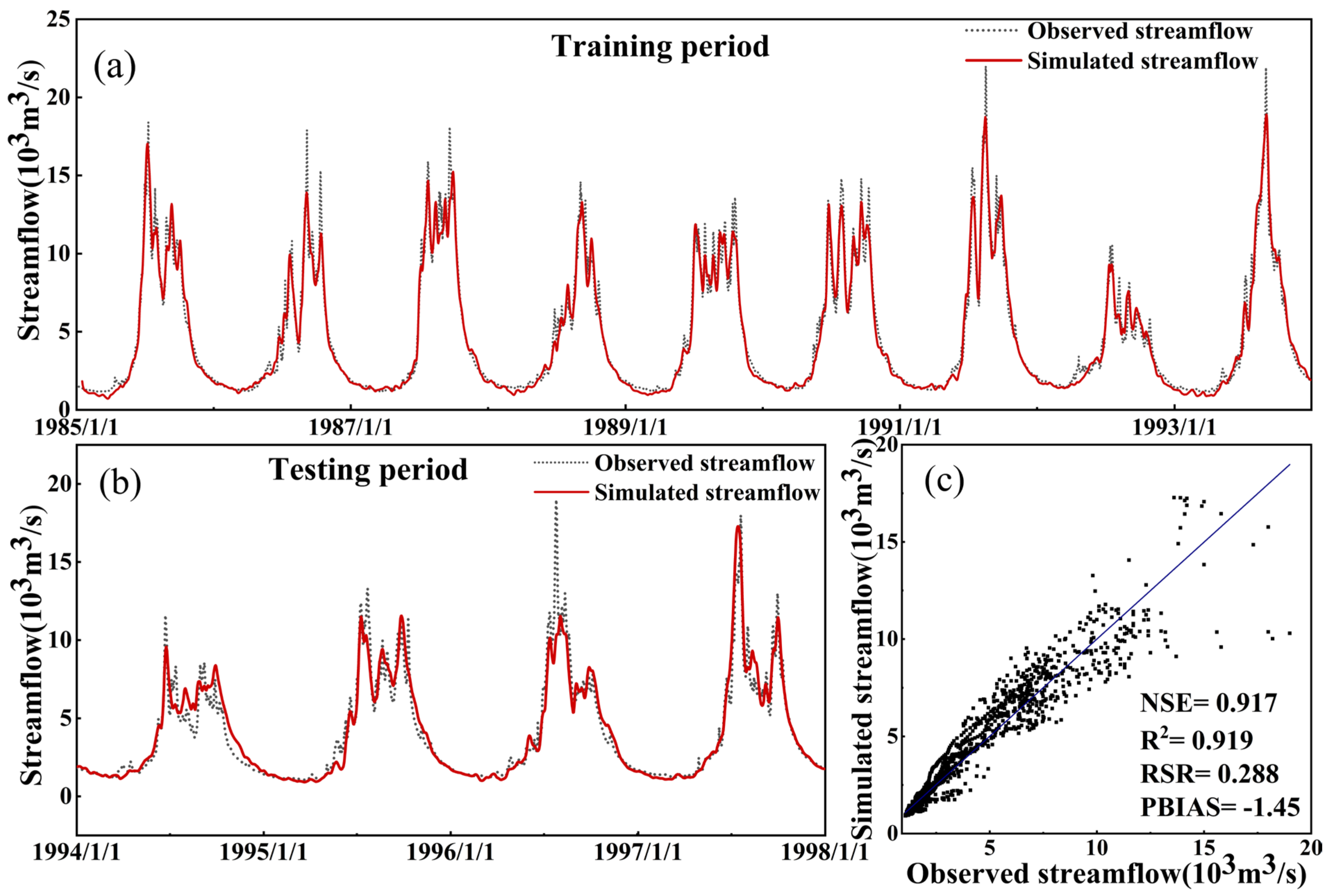
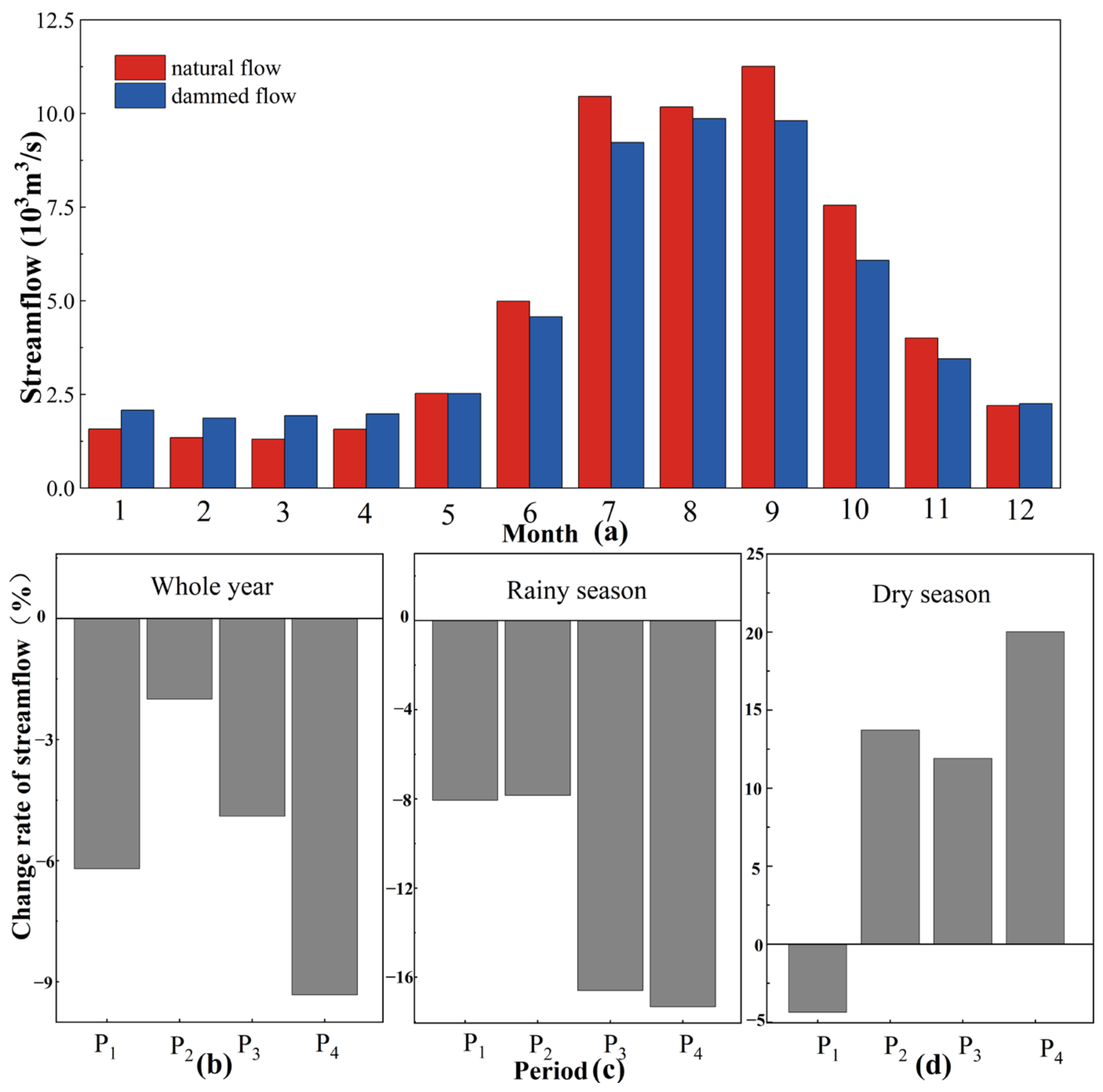
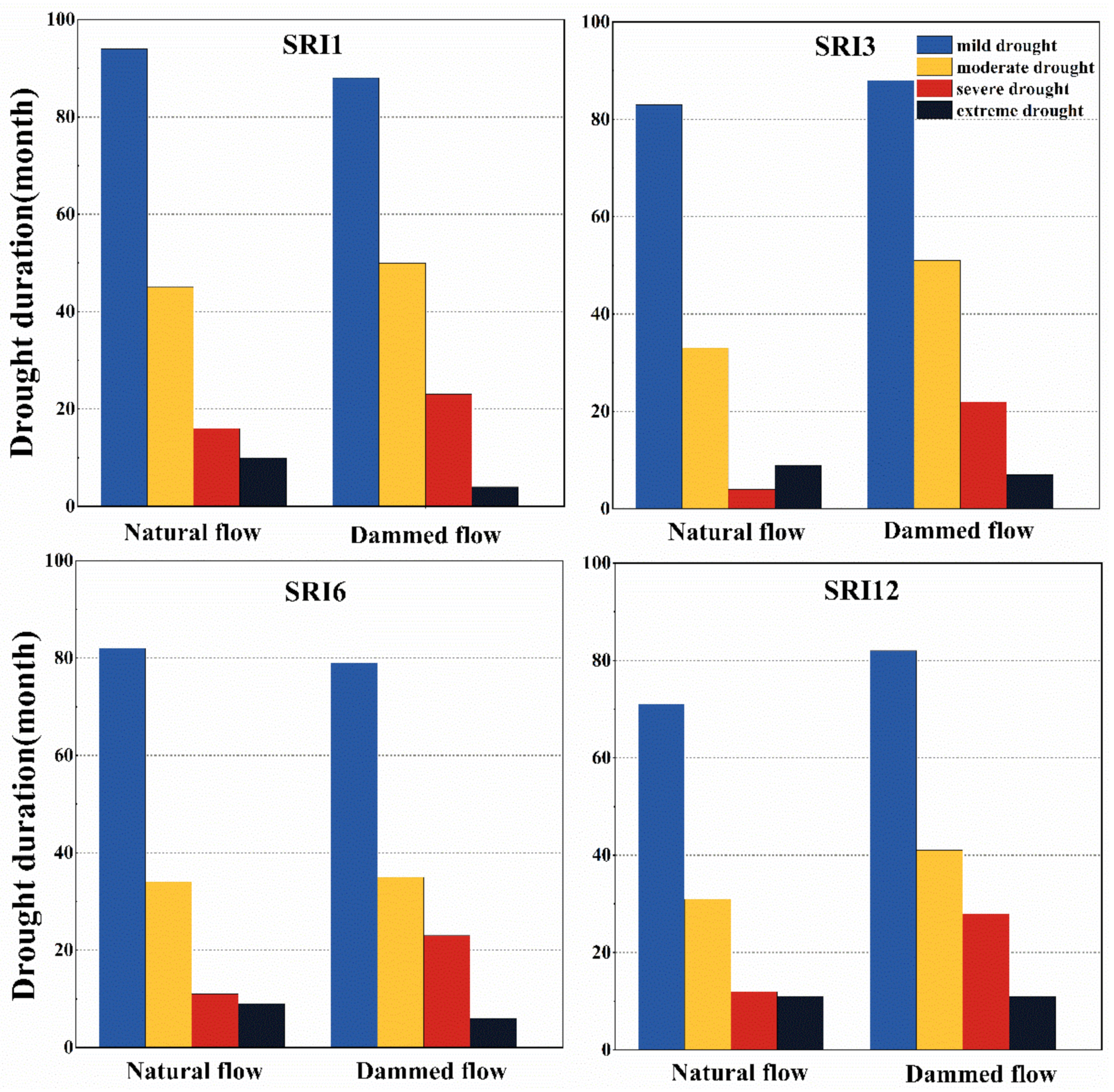
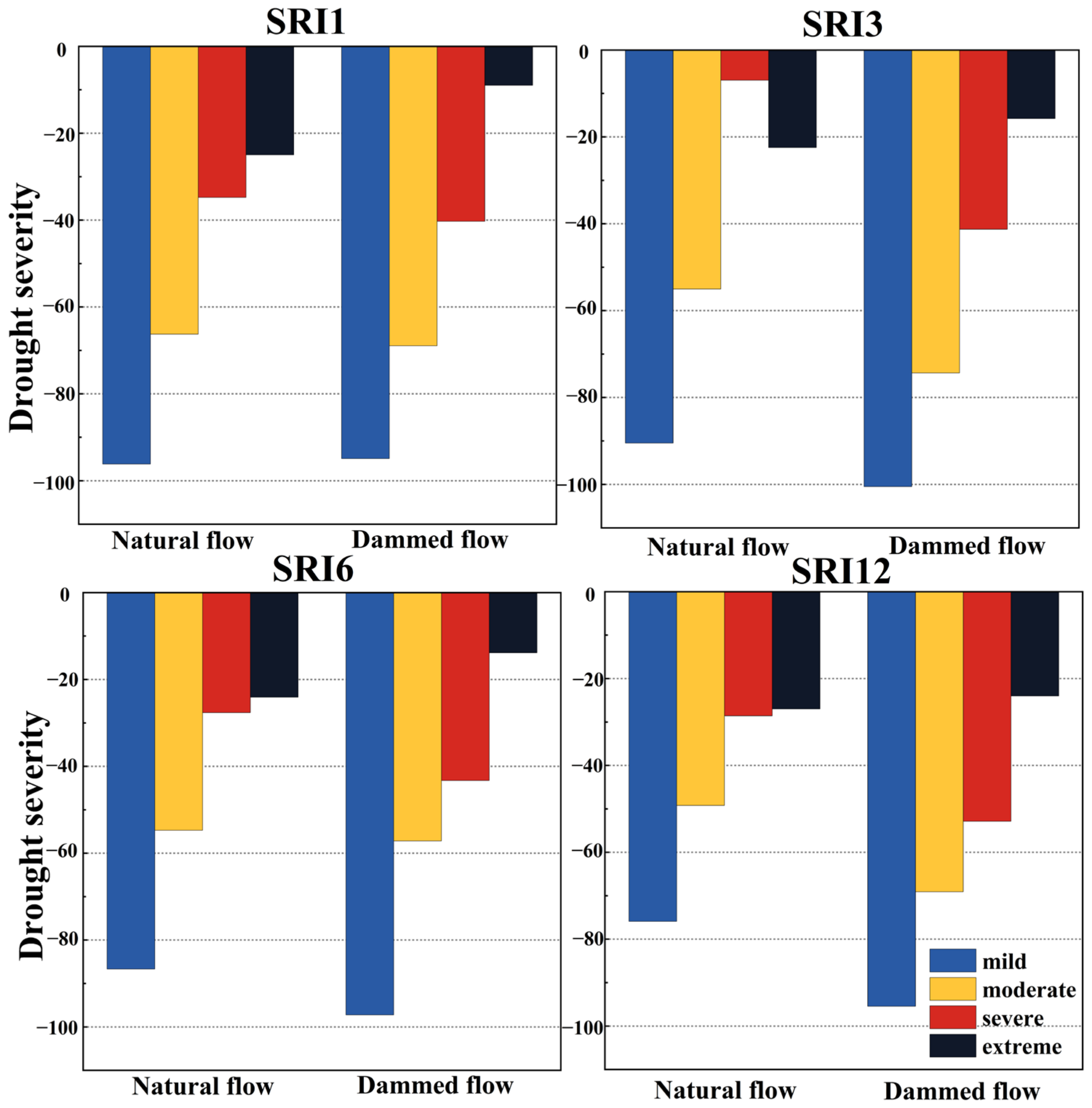
| Dam | Installed Capacity | Total Storage | Regulated Storage Capacity | Regulation Type | Reservoir Filling |
|---|---|---|---|---|---|
| (MWh) | (106 m3) | (106 m3) | |||
| Liyuan | 2400 | 727 | 173 | Weekly | 2014 |
| Ahai | 2000 | 806 | 238 | Daily | 2011 |
| Jinanqiao | 2400 | 847 | 346 | Weekly | 2010 |
| Longkaikou | 1800 | 558 | 113 | Daily | 2012 |
| Ludila | 2160 | 1718 | 376 | Weekly | 2013 |
| Guanyinyan | 3000 | 2072 | 383 | Weekly | 2014 |
| Wudongde | 10,200 | 7408 | 3020 | Seasonal | 2020 |
| Xiluodu | 12,600 | 12,670 | 6460 | Incomplete year regulation | 2013 |
| Xiangjiaba | 6000 | 5163 | 903 | Incomplete year regulation | 2012 |
| Lianghekou | 3000 | 10,800 | 6560 | Multi-year | 2020 |
| Jinping I | 3600 | 7760 | 4910 | Annual | 2012 |
| Jinping II | 4800 | 14.28 | 4.96 | Daily | 2012 |
| Guandi | 2400 | 760 | 28.4 | Annual | 2012 |
| Ertan | 3300 | 5800 | 3370 | Annual | 1998 |
| Tongzilin | 600 | 91.2 | 23.1 | Daily | 2015 |
| Data Type | Data Feature | Time Step | Products | Data Source |
|---|---|---|---|---|
| Streamflow | Hydrological station | daily | Observed | Pingshan and Xiangjiaba Hydrological Stations |
| Precipitation | 0.25° × 0.25° | daily | CHIRPS-2.0 | https://data.chc.ucsb.edu/ (accessed on 25 September 2021) |
| Air temperature | 0.1° × 0.1° | hourly | ERA5-LAND | https://cds.climate.copernicus.eu/ (accessed on 15 September 2021) |
| Snow melt | 0.1° × 0.1° | hourly | ERA5-LAND | https://cds.climate.copernicus.eu/ (accessed on 15 September 2021) |
| Evaporation | 0.1° × 0.1° | hourly | ERA5-LAND | https://cds.climate.copernicus.eu/ (accessed on 15 September 2021) |
| Soil moisture | 0.25° × 0.25° | daily | GLDAS | https://disc.gsfc.nasa.gov/ (accessed on 31 October 2021) |
| Model | Testing Period | NSE | Source |
|---|---|---|---|
| LSTM | 1994–1998 | 0.92 | This study |
| SWAT (Semi-distributed Model) | 2000–2016 | 0.90 | Chen et al. (2020) [38] |
| SWAT (Semi-distributed Model) | 2012–2012 | 0.71 | Wu et al. (2020) [20] |
| Xinanjiang model (Distributed model) | 1986–2000 | 0.84 | Feng et al. (2018) [6] |
| VIC model (Distributed model) | 2004–2006 | 0.72 | Maza et al. (2020) [39] |
| MIKE 11 NAM model (Distributed model) | 2009–2015 | 0.83 | Aredo et al. (2021) [37] |
Disclaimer/Publisher’s Note: The statements, opinions and data contained in all publications are solely those of the individual author(s) and contributor(s) and not of MDPI and/or the editor(s). MDPI and/or the editor(s) disclaim responsibility for any injury to people or property resulting from any ideas, methods, instructions or products referred to in the content. |
© 2023 by the authors. Licensee MDPI, Basel, Switzerland. This article is an open access article distributed under the terms and conditions of the Creative Commons Attribution (CC BY) license (https://creativecommons.org/licenses/by/4.0/).
Share and Cite
Zhang, K.; Yuan, X.; Lu, Y.; Guo, Z.; Wang, J.; Luo, H. Quantifying the Impact of Cascade Reservoirs on Streamflow, Drought, and Flood in the Jinsha River Basin. Sustainability 2023, 15, 4989. https://doi.org/10.3390/su15064989
Zhang K, Yuan X, Lu Y, Guo Z, Wang J, Luo H. Quantifying the Impact of Cascade Reservoirs on Streamflow, Drought, and Flood in the Jinsha River Basin. Sustainability. 2023; 15(6):4989. https://doi.org/10.3390/su15064989
Chicago/Turabian StyleZhang, Keyao, Xu Yuan, Ying Lu, Zipu Guo, Jiahong Wang, and Hanmin Luo. 2023. "Quantifying the Impact of Cascade Reservoirs on Streamflow, Drought, and Flood in the Jinsha River Basin" Sustainability 15, no. 6: 4989. https://doi.org/10.3390/su15064989
APA StyleZhang, K., Yuan, X., Lu, Y., Guo, Z., Wang, J., & Luo, H. (2023). Quantifying the Impact of Cascade Reservoirs on Streamflow, Drought, and Flood in the Jinsha River Basin. Sustainability, 15(6), 4989. https://doi.org/10.3390/su15064989






